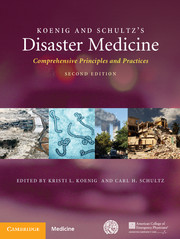Book contents
- Koenig and Schultz's Disaster MedicineSecond Edition
- Dedication
- Koenig and Schultz's Disaster Medicine
- Copyright page
- Contents
- Contributors
- Foreword
- Perspective
- Preface
- Part I Conceptual Framework and Strategic Overview
- Part II Operational Issues
- 11 Public Health and Emergency Management Systems
- 12 Legislative Authorities and Regulatory Issues
- 13 Syndromic Surveillance
- 14 Triage
- 15 Personal Protective Equipment
- 16 Decontamination
- 17 Quarantine
- 18 Mass Dispensing of Medical Countermeasures
- 19 Management of Mass Gatherings
- 20 Transportation Disasters
- 21 Emergency Medical Services Scene Management
- 22 Healthcare Facility Disaster Management
- 23 Mass Fatality Management
- 24 Rehabilitation of Disaster Casualties
- 25 Crisis and Emergency Risk Communication
- 26 Telemedicine and Telehealth:
- 27 Complex Public Health Emergencies
- 28 Patient Identification and Tracking
- Part III Clinical Management
- Index
- References
14 - Triage
from Part II - Operational Issues
Published online by Cambridge University Press: 05 April 2016
- Koenig and Schultz's Disaster MedicineSecond Edition
- Dedication
- Koenig and Schultz's Disaster Medicine
- Copyright page
- Contents
- Contributors
- Foreword
- Perspective
- Preface
- Part I Conceptual Framework and Strategic Overview
- Part II Operational Issues
- 11 Public Health and Emergency Management Systems
- 12 Legislative Authorities and Regulatory Issues
- 13 Syndromic Surveillance
- 14 Triage
- 15 Personal Protective Equipment
- 16 Decontamination
- 17 Quarantine
- 18 Mass Dispensing of Medical Countermeasures
- 19 Management of Mass Gatherings
- 20 Transportation Disasters
- 21 Emergency Medical Services Scene Management
- 22 Healthcare Facility Disaster Management
- 23 Mass Fatality Management
- 24 Rehabilitation of Disaster Casualties
- 25 Crisis and Emergency Risk Communication
- 26 Telemedicine and Telehealth:
- 27 Complex Public Health Emergencies
- 28 Patient Identification and Tracking
- Part III Clinical Management
- Index
- References
- Type
- Chapter
- Information
- Koenig and Schultz's Disaster MedicineComprehensive Principles and Practices, pp. 208 - 218Publisher: Cambridge University PressPrint publication year: 2016
References
- 2
- Cited by



